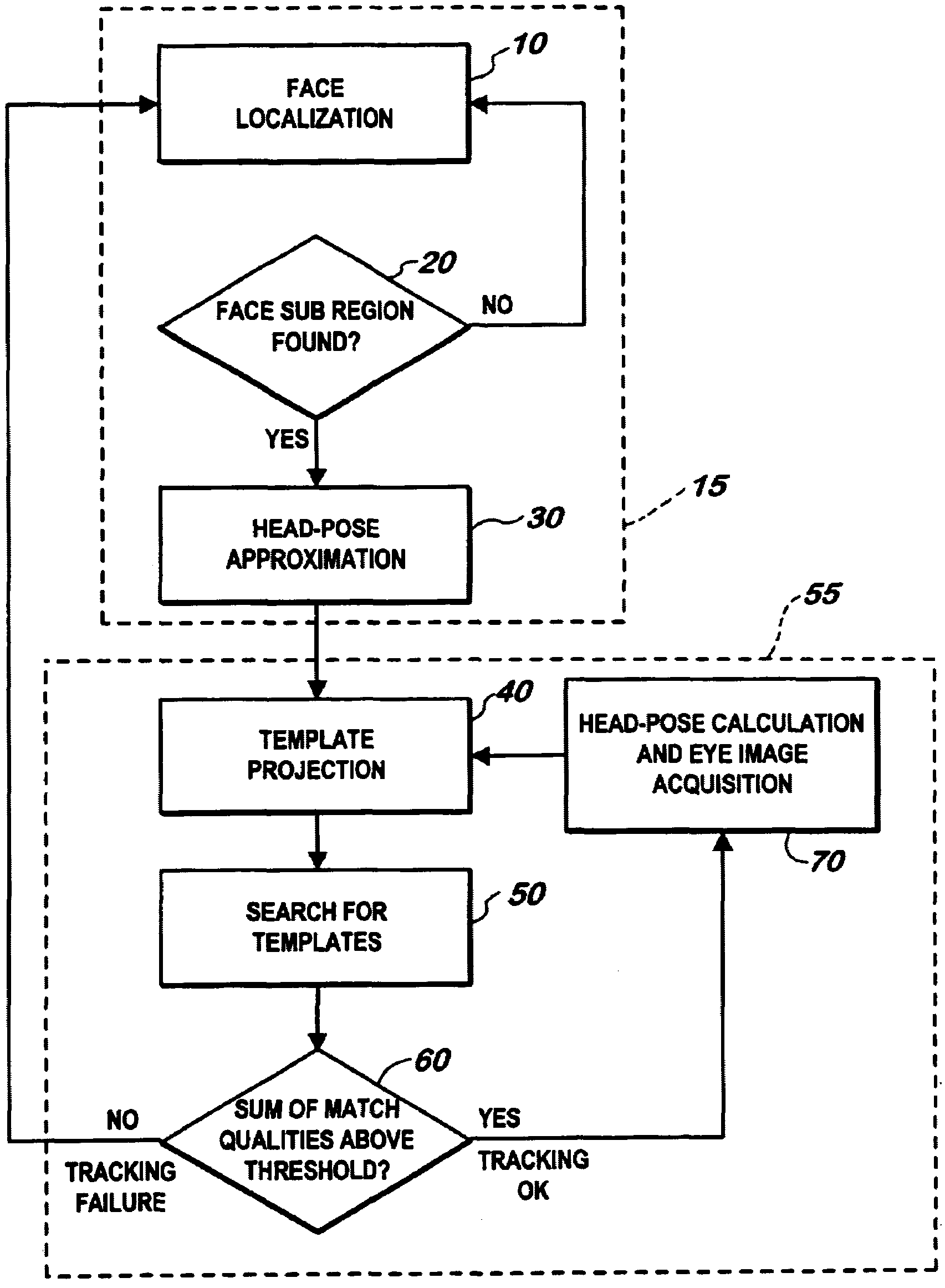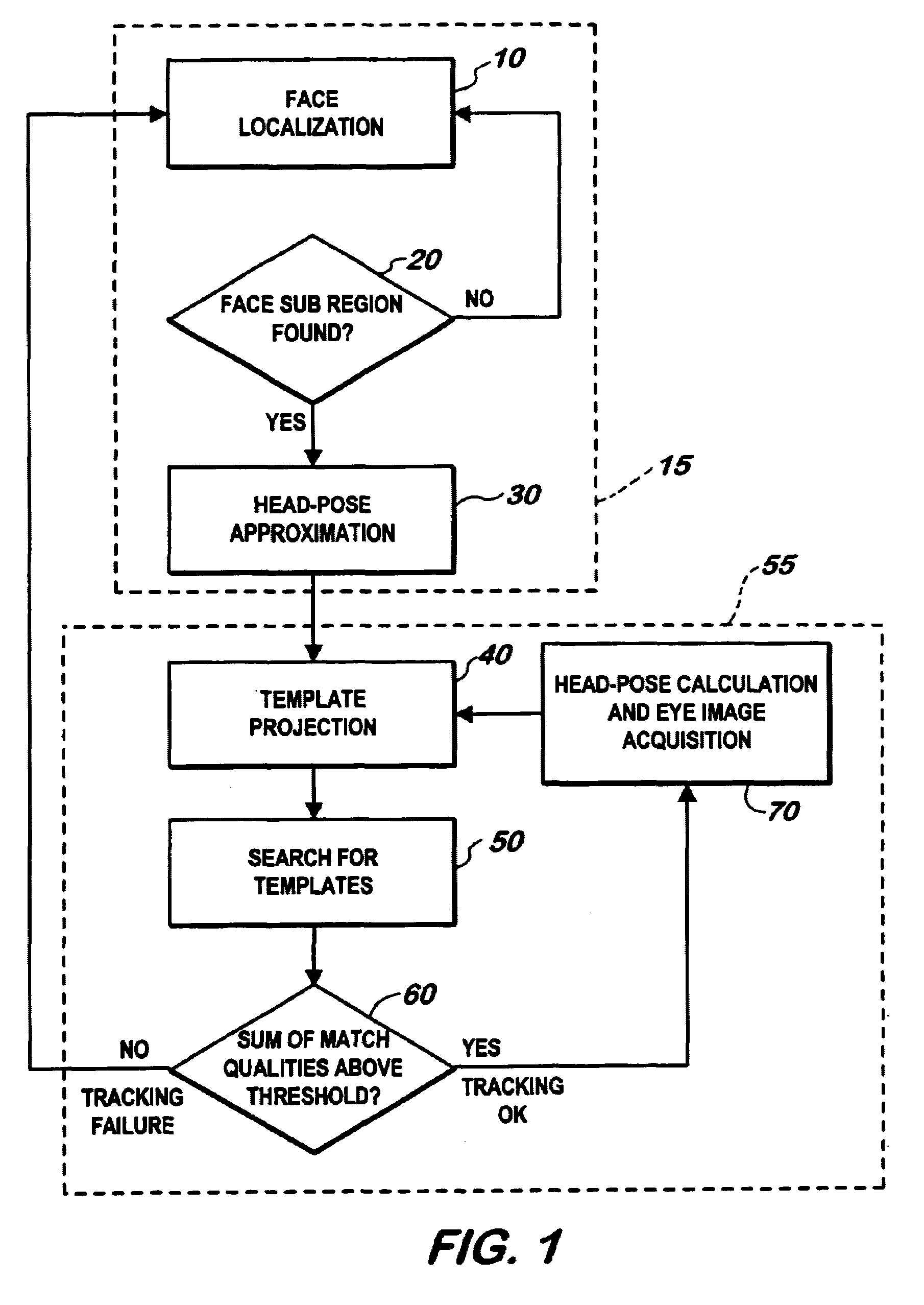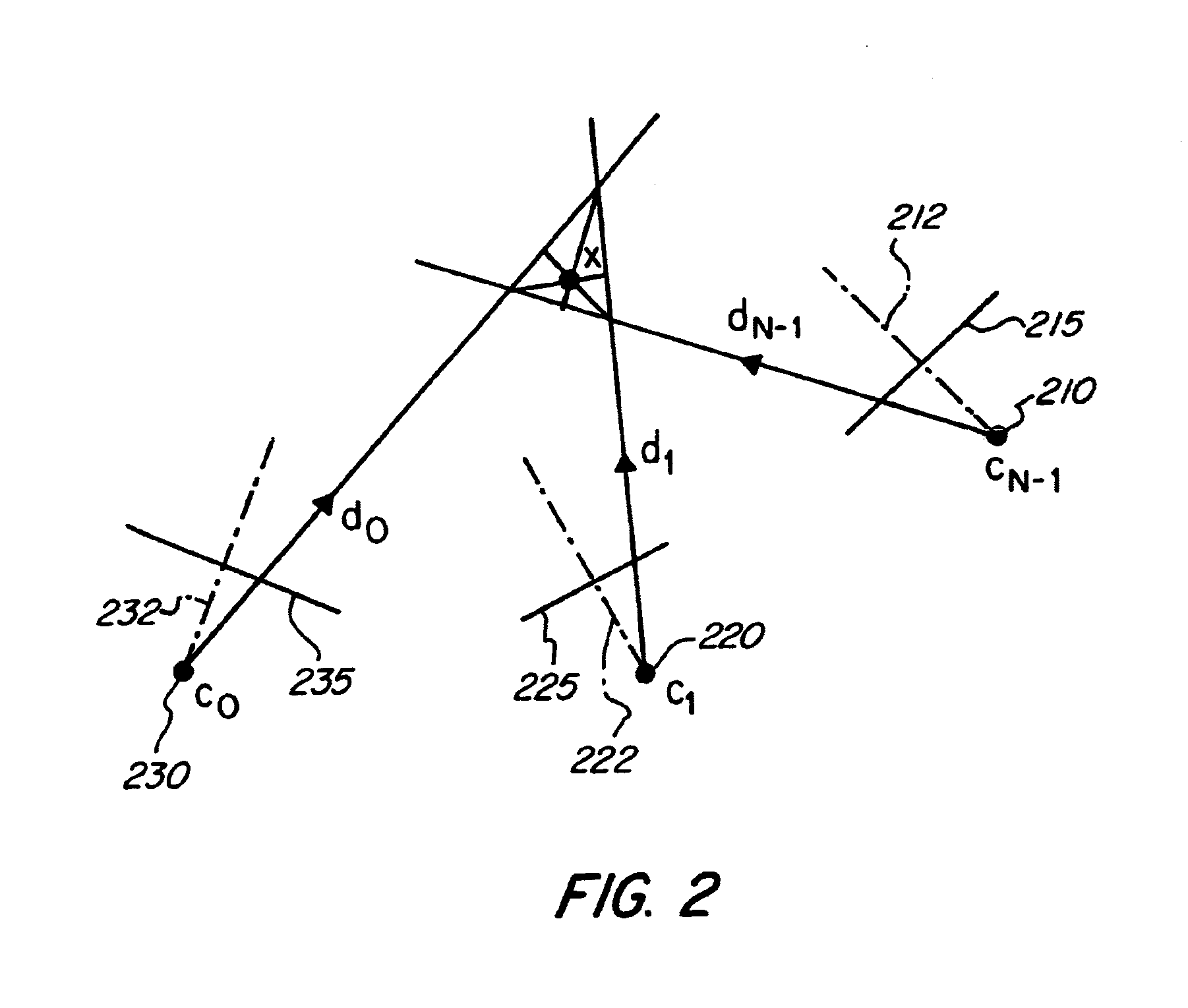Wearing a device of any sort is clearly a
disadvantage, as the user's competence and acceptance to wearing the device then directly effects the reliability of the
system.
Devices are generally intrusive and will affect a user's behaviour, preventing natural motion or operation.
However, the technique is prone to error in conditions of lighting variation and is therefore unsuitable for use under natural lighting conditions.
The lack of a more detailed gaze analysis clearly limits the usefulness of such a
system.
The main problem with the approach is that only head orientation can be measured—head translation is not accounted for.
Another difficulty is that the set of candidate head positions must be generated in advance.
This is a laborious process.
The technique is computationally expensive, and the accuracy is largely dependent on the similarity between the generic
mesh model and the actual head being tracked.
The wide variety of human
face structure thus prevents any guaranteed measure of accuracy.
Convergence of this technique is not assured due to the typical variation of human
facial geometry.
This is a similar problem to the Template
Mesh Model Fitting technique, though a little lessened due to the adaptive approach used.
It is also important to note that the technique is fragile to facial deformations such as smiling and blinking.
Both methods are fragile if applied to tasks that involve wide
ranging head motions, such as when driving a car.
The system cannot be used for practical head-
pose tracking as it is fragile to head and eye motion (including blinking), and requires the image background to be uniform.
The range and accuracy of head-
motion measurement is also very limited due to the deformation and / or
occlusion of features as the head is moved.
However the system described has no facility for using the head-pose information to reliably track eye-gaze.
Again, as for head-pose direction, wearing a device of any sort is a
disadvantage, as the user's competence and acceptance to wearing the device then directly effects the reliability.
Devices are generally intrusive and will affect a user's behaviour, interfering with natural motion and operation.
However, the technique is limited for the following reasons:
This limits the use of infra-red to applications where gaze is restricted to a small area.
Due to finite
image sensor resolution, this limits the possible field-of-view for the sensor.
To overcome this problem, either a very expensive high-resolution sensor must be used, or a bulky and failure-prone mechanical pan-tilt mechanism can be employed.
Natural lighting conditions can easily confuse the reflection detection process.
Flashing techniques are often used to improve reliability, however saturation of the
pupil with
sunlight will cause a flashing
detector to fail.
Fluctuating light on the
pupil, typical of driving conditions, will also produce erroneous measurements.
Techniques to compensate for motion toward or away from the camera are based on measuring the
image area of the reflections or other regions on the face, and are prone to
noise due to resolution constraints, overlapping reflections from other light sources, and
distortion introduced by rotation of the head.
Passive eye-gaze analysis is not actually performed.The technique performs eye-gaze tracking without three-dimensional head-
pose tracking to compensate for head orientation and motion, thus limiting the application of the technique to strict translations in the
image plane, or no head-motion at all.
Neural networks require long training sequences for every person to be monitored, and do not allow for any head motion.
The techniques based on finding the
distortion of the iris circle due to eye rotation tend to be extremely
noise and resolution sensitive.
The technique only locates the eyes, and does not perform any actual eye-gaze measurement.
Each of the above techniques fails to account for three-dimensional motion of the head, and are prone to error due to head-rotation and head-translation along the camera axis.
Clearly wearing a device of any sort is a
disadvantage, as the user's competence and acceptance to wearing the device then directly effects the reliability.
Devices are generally intrusive and will affect a user's behaviour, interfering with natural motion and operation.
The blink technique described is defective in situations where an operator's head rotates significantly, due to the inadequate head-
pose tracking.
A technique that determines the ratio of the areas of the eye and
eyebrow image regions is used to add robustness to variation in head-pose distance from the camera This technique may be unreliable when the head is rotated left and right, as rotational motion of the head in this plane will cause the
eyebrow and eye image-region area-ratio to change which will be interpreted as a change in head-pose distance.
The technique will also be unreliable when used on operators with fair or blonde eyebrows, when the eyebrows are moved around on the face, or when reflected light conditions on the
eye change.
Additionally, the technique will not work at all when using glasses or sunglasses, at the very least due to the fact that the frames will cover the
eyebrow image regions.
Thus, the techniques have failed to take
advantage of the relationships between the measures, and, in general, are limited in their application due to over-simplified approaches to the
measurement problem.
More specifically, the known techniques have not suitably accounted for large variations in
head position and rotation when measuring eye-gaze, eye-closure or blink event detection, and thus although claiming to be robust, are only robust given specific restrictions on head-pose.
Thus the known techniques remain fragile when applied to head motions typical of operating a
machine in a seated position, such as driving a car.
Additionally, no prior technique is known that automatically detects which parts of the face are flexible.
It does not simplify the
animation process for capturing facial expressions that involve
eyelid, eyeball, eyebrow and other facial expressions not involving the mouth.
As the technique only tracks the nostrils, it will only be so while the nostrils are visible to the camera Clearly the system will fail for head orientations where the head is tilted forward so that the nostrils are obscured from the camera by the top of the
nose.
 Login to View More
Login to View More  Login to View More
Login to View More 


